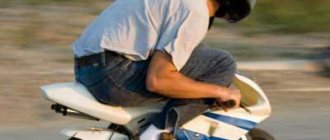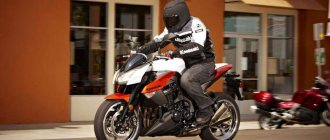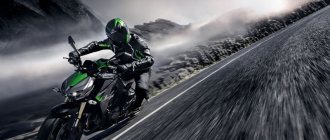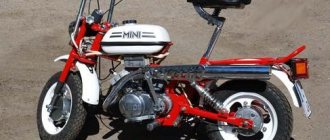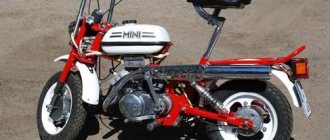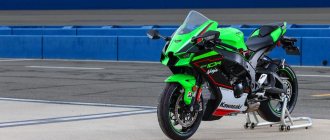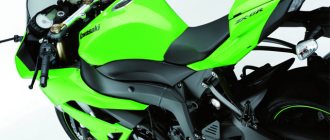Kawasaki Z1000
Kawasaki motorcycles of the Z1000 family - both naked and sport-tourist SX - are in modest but stable demand on the Russian market. And both new and used. What is wrong with a used “liter”?
STORY
In 2010, Kawasaki dared to completely redesign its Z1000 roadster. The power unit, created on the basis of the engine from the ZX-9R sports bike, has been increased in volume to 1043 cm³. Maximum power has increased to 138 hp, and the emphasis has been placed on better traction at low and medium speeds. Completely new chassis: the frame is made of aluminum alloy, the rear suspension is with a horizontal monoshock absorber.
Exactly a year later, the Z1000SX model (aka Ninja 1000 and Ninja 1000 Tourer for the US market) was introduced - a variation on the theme “shouldn’t we make a sports tourer out of a roadster?” The naked bike was fitted with a large fairing, a larger gas tank (19 liters), high clip-ons instead of a standard steering wheel, an adjustable windshield and mounts for panniers.
In the fall of 2013, the Japanese presented a seriously modernized pair of Zeds. Moreover, the “undressed” one was strikingly different in appearance from its predecessor (the previous angularity gave way to a rounded biodesign, which made it look like Hans Giger’s “Alien”), while the interference in the design was exclusively of a targeted nature. So, for the sake of greater sharpness of reactions, the injection maps were rewritten and up to 142 hp. recoil increased. For the same purpose, the wheelbase was shortened by 10 mm (1435 mm), the old fork with a 41 mm diameter of stays was replaced with a Showa SFF-BP with separate hydraulic functions (one feather is responsible for compression, the second for rebound), and the brakes are reinforced with radial “ monoblocks" Tokico. Clad in fairings, the SX also received a mode switch, traction control and ABS as standard equipment, although nothing in its appearance betrayed anything new (except perhaps a different instrument cluster).
The Kawasaki Z1000SX sports tourer received a deep facelift (the Japanese are talking about the third generation) in 2022: on the one hand, the design of its cladding became fashionably faceted and similar to the top Ninja, on the other hand, they better protected the driver (in the lower part the fairing is wider by 56 mm, and the double-radius windshield is 15 mm higher). LED headlights have improved efficiency, according to the creators, by 1.4 times. The on-board electronics (these are two engine operating modes, ABS, traction and anti-wheelie) have learned to recognize tilt movement using the IMU inertial sensor. Purely touring advantages were not forgotten either: the saddle became more comfortable, a system for attaching panniers was included in the basic package, and an indicator of the engaged gear appeared on the instrument panel.
SX meets the new year 2022 noticeably younger and with a different name - Ninja 1000SX. Read the material about the Milan EICMA exhibition in the same issue.
FOR WHAT
Powerful, simple and relatively affordable. Z1000 in any version is clear and adequate. Its inline-four is almost vibration-free, pulls well in the lower and middle range, and its gears are “chopped” close to each other, resulting in a dizzying acceleration to hundreds in 3.5 seconds. Of course, the pace slows down further, but the maximum 236 km/h is more than enough to turn you into a pedestrian for a year.
At the presentation of the modernized “liter” in 2014, Kawasaki engineers especially emphasized how, for the sake of thrill, they made throttle responses sharp, instantaneous. Alas, the reality turns out to be somewhat different: if you drop the speed below 4000 rpm, a jerk when opening the gas cannot be avoided. In an upright position, such a zealous rush of the Kawasaki engine excites and amuses, but in a deep tilt the driver will need additional accuracy.
It’s also sad that the obstinacy of the character is by no means compensated by the refinement of the chassis. The big Zed is characterized by a heavy tread - stiff suspensions that throw you off course, as well as a blatant lack of feedback, forcing you to roll trajectories at random. In addition, the Z1000 begins to grind on the asphalt unforgivably early: first with the footpegs, and then with the mufflers, which forces it to hang down more than usual.
CHOICE
The Z1000 engine is generally considered to be quite reliable, although quite vibration-loaded and noisy. And so much so that the motor itch is not only felt on the steering wheel, completely “clogging” the hands and fingers, but also negatively affects the throttle valve unit, forcing one to resort to balancing and synchronization much more often than the prescribed periods.
At the same time, in the general mechanical cacophony, it is worth highlighting individual sounds. For example, a rhythmic noise from the top of the engine can be a consequence of both loose exhaust manifold nuts (the studs are made of a fairly soft metal, which is why, if you overdo it, it’s easy to break the threads), or the intermediate position of the automatic timing belt tensioner (no big deal - it’s soon it will jump one tooth further, and the noise will disappear). In addition, on the sports-touring SX, over time, due to wear and tear of the seats, the plastic fairing panels begin to “talk.” The fact that the valve cover has at least been removed will be indicated by oil leaks underneath it: the rubber gasket has a complex shape and, if assembled incorrectly, becomes skewed, especially in the area of the camshaft position sensor. To greatly facilitate the process, it makes sense to apply silicone grease to the gasket immediately before installation.
By the way, they could have removed it due to a torn valve - this sometimes happens on all types of zadoks, regardless of mileage and degree of fatigue. It also happens that due to a design feature, when the oil and water pumps are driven from the same gear, the oil seals give out unexpectedly early, and coolant begins to ooze from under them. If individual drops are fine (at least, that’s what they say in the company itself). But if it flows without stopping, and even with traces of oil, that’s a reason to refuse the purchase.
Clutch twitching when starting “cold” after a long stay is explained by the lack of oil at this moment on the working surfaces of the friction discs. In official service, this ailment is usually “treated” by drilling additional holes in the clutch basket. But a more effective, although not cheap (over 1,000 euros) method is to install a slipper clutch from the platform Versys 1000 and Z1000SX models of 2015 and 2022, respectively: it is squeezed out easier and operates more softly when braking the engine.
The gearbox usually doesn't cause any problems. False neutrals, howling sounds and stubbornness when changing gears, which owners of Kawasaki “liters” often complain about, appear exclusively on untested cars or when handled carelessly. Moreover, all complaints usually disappear immediately as soon as refinement appears in the movements of the leg.
Be extremely careful when removing the air filter box and do not inadvertently remove the throttle position sensor. And this is easy to do, because it is located in close proximity to the airbox latches. I disconnected the sensor from the seat - and that’s it, it won’t be possible to recalibrate it, you will have to change the entire throttle battery (about 2100 euros).
Electrics rarely throw up “surprises”. Unless the relay-regulator fails, after which the generator usually also dies. Therefore, it is necessary to constantly monitor the condition of the node. When the engine is off, the voltage at the battery terminals should be 12.8 V or higher, while when the engine is running - 14.2-14.8 V. Any deviations indicate a problem.
TUNING
The close relationship of the Z1000 power unit with the ZX-9R engine greatly simplifies the process of finding additional “horses”: stuck in the “humpbacked” camshafts from the “nine”, reconfigured the injection maps - and now your “tops” have noticeably risen. Albeit to the detriment of the “lower classes”. But serious tuning is for enthusiasts. The vast majority of owners limit themselves to much more modest modifications. First of all, by installing a front fender extension and a rear fender liner, which help protect the engine, radiator, rear shock absorber and passenger from flows of dirt and sand. Next in line are windshields of different colors and shapes (oddly enough, this is not only true for the SX). Those who are used to spending a lot of time on long journeys also change the driven sprocket (41 teeth) to a smaller option, otherwise on freeways, due to a “shorted” main pair, sometimes you want to engage the non-existent seventh gear. Is everything wrong? In this case, there are always many different companies ready to fulfill any whim. Not at all free, of course.
WHERE TO LOOK
The search location depends solely on your income. If you find money for a new Z1000, go straight to official dealers. No - welcome to the secondary market. It makes sense to start with offers from private individuals, where traditionally you can stumble upon both outright rubbish and tempting options. If you want equipment “without mileage in the CIS,” then numerous “gray” importers will be happy to bring it from Japan, the USA and Canada.
Electric motorcycle for adults Z1000 (3-15kW / 20-150Ah)
Features of the model depending on the modification:
| Engine power | 3000w | 5000w | 8000w | 15000w | ||||
| battery | Max. speed | Power reserve | Max. speed | Power reserve | Max. speed | Power reserve | Max. speed | Power reserve |
| 20Ah (72v SLA) | 75 km/h | 45 km | 120 km/h | — | 150 km/h | — | 180 km/h | — |
| 32Ah (72v SLA) | 59 km | — | — | — | ||||
| 40Ah (72v SLA) | 78 km | — | — | — | ||||
| 45Ah (72v SLA) | 94 km | — | — | — | ||||
| 40Ah (72v Li-ion) | 87 km | 70 km | 57 km | — | ||||
| 55Ah (72v Li-ion) | 120 km | 96 km | 78 km | — | ||||
| 60Ah (72v Li-ion) | 130 km | 104 km | 85 km | — | ||||
| 90Ah (72v Li-ion) | 196 km | 157 km | 127 km | — | ||||
| 120Ah (72v Li-ion) | 270 km | 210 km | 170 km | 125 km | ||||
| 150Ah (72v Li-ion) | 320 km | 250 km | 200 km | 155 km | ||||
Electric motorcycle for adults Z1000 (3-15kW / 20-150Ah) is suitable for traveling on asphalt roads and sport riding. The motorcycle has a stylish, sporty design. The motorcycle has a high-strength steel frame and an aluminum foot pedal. The design of the motor vehicle can withstand a maximum load of up to 200 kg, which allows the use of an electric bike by users with excess body weight. A system of front and rear dual disc brakes ensures a safe stop while driving. It is possible to install ABS.
Other design characteristics of the electric motorcycle:
- Dimensions: 220x110x100 cm.
- The electric bike is equipped with 17-inch wheels.
- There is a liquid crystal display on the dashboard.
- The motorcycle is equipped with rear-view mirrors located on the handlebars.
- The LED front headlight and tail light enhance safety during night driving.
The model can be additionally equipped with a replica Brambo brake system, a wide rear wheel and a cantilever swingarm. The motorcycle is also equipped with hard side panniers for transporting light loads, a seat upholstery and a protective cover. It is possible to install Bluetooth speakers for listening to music. Motor vehicles can be equipped with waterproofing to protect against water ingress.
You can buy an electric motorcycle for adults Z1000 (3-15kW / 20-150Ah) on the Formand online store website. Our store delivers goods throughout Moscow, the Moscow region and other regions of Russia.
Contents of delivery:
- Electric motorcycle for adults Z1000 (3-15kW / 20-150Ah);
- Battery (selection taking into account the power of the electric motor);
- Charger;
- Step;
- User manual;
- Warranty card.
Kawasaki motorcycle range
The production of motorcycles under the Kawasaki brand is carried out by one of the many divisions of the Japanese corporation Kawasaki Heavy Industries, Ltd. It was formed in 1963. The scope of the company's interests has expanded greatly since 1887 thanks to the persistence of its creator Shozo Kawasaki. This includes shipbuilding, aircraft manufacturing, heavy industry and space research. A new field of activity developed to replace aircraft production, which was not restored after the war.
In order to popularize the Kawasaki brand, which is widespread in narrow circles, new motorcycles began to represent the company at domestic motorcycle racing. But this niche was already occupied, so we had to conquer overseas markets. To do this, it was necessary to modernize existing models. The first attempts with the Meguro and W1 bikes were disastrous. So the engineers' attention switched to speed characteristics and smooth cornering. This is how the Kawasaki 500SS MachIII and 650 W1 Commando appeared, which earned the respect of the Americans. Later, the era of the Z model began. In the 70s, the road GPZ debuted with Uni-Trak suspension. The Vulcan series model line has become iconic.
In post-Soviet Russia, used Kawasaki motorcycles first debuted. This market segment became more promising in 2006, when a full-fledged dealer network was formed that sold and serviced Japanese equipment.
The supersport category features Kawasaki Ninja bikes in six variants with a 4-stroke, 4-cylinder engine. The front brakes are double-disc and the rear are hydraulic disc. The main difference between motorcycles is engine size.
Today, the Kawasaki line of road motorcycles includes two dozen bikes. They have a spacious fuel tank and a comfortable seating position, although the “beds” have a slight forward tilt. The drive is chain, the suspension is designed to overcome unevenness on the road. It will not be possible to attach the trunk; there are no fastenings.
Motorcycles of the sport-touring type are covered with plastic covering, equipped with wind protection, and panniers can be attached. The tank holds 20 liters of fuel. The Kawasaki 1400GTR ABS has a cardan drive.
Choppers and cruisers shine with chrome details, the back seat is slightly raised, and some have backrests.
Enduro is easy to overcome any obstacles. KLX models are equipped with a flexible front fender and a small tank. The Kawasaki Versys is more powerful and bigger.
The small-capacity Kawasaki KX65 is ideal for learning motocross. It is lightweight, maneuverable and safe.
